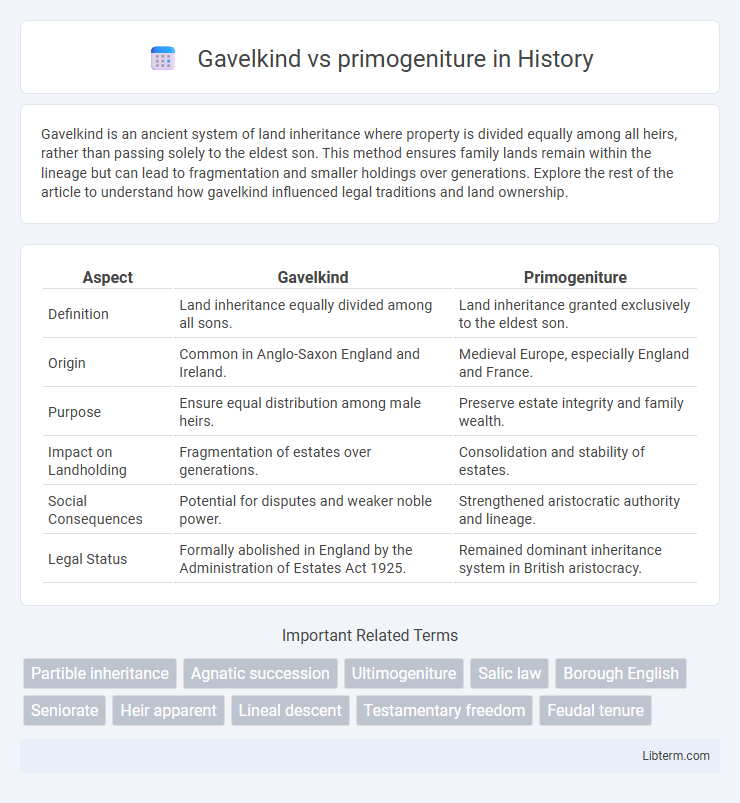Gavelkind is an ancient system of land inheritance where property is divided equally among all heirs, rather than passing solely to the eldest son. This method ensures family lands remain within the lineage but can lead to fragmentation and smaller holdings over generations. Explore the rest of the article to understand how gavelkind influenced legal traditions and land ownership.
Table of Comparison
| Aspect | Gavelkind | Primogeniture |
|---|---|---|
| Definition | Land inheritance equally divided among all sons. | Land inheritance granted exclusively to the eldest son. |
| Origin | Common in Anglo-Saxon England and Ireland. | Medieval Europe, especially England and France. |
| Purpose | Ensure equal distribution among male heirs. | Preserve estate integrity and family wealth. |
| Impact on Landholding | Fragmentation of estates over generations. | Consolidation and stability of estates. |
| Social Consequences | Potential for disputes and weaker noble power. | Strengthened aristocratic authority and lineage. |
| Legal Status | Formally abolished in England by the Administration of Estates Act 1925. | Remained dominant inheritance system in British aristocracy. |
Introduction to Succession Laws
Succession laws such as gavelkind and primogeniture dictate the inheritance of property and titles, significantly shaping family wealth and power distribution. Gavelkind, historically practiced in parts of England and Ireland, mandates equal division of an estate among all male heirs, promoting shared family ownership and preventing estate fragmentation. Primogeniture, prevalent across much of Europe, grants the entire estate to the eldest son, consolidating land and wealth to maintain noble lineage and social hierarchy.
Defining Gavelkind: Origins and Practices
Gavelkind is a traditional system of land inheritance originating from medieval England and notably practiced in Kent, where property was divided equally among all sons rather than passed to the eldest heir alone. This practice ensured that each male descendant received a portion of the family estate, preventing the consolidation of wealth but often leading to fragmented land holdings. Unlike primogeniture, which centralized inheritance, gavelkind maintained a more egalitarian distribution of property within families.
Understanding Primogeniture: Core Principles
Primogeniture is a hereditary succession system where the firstborn child, typically the eldest son, inherits the entire estate, preserving family wealth and land intact across generations. This principle contrasts with gavelkind, where property is divided equally among all heirs, often leading to fragmented estates. Primogeniture's focus on singular inheritance aims to maintain social stability and economic power within elite families.
Historical Context: Medieval Europe’s Inheritance Systems
In medieval Europe, gavelkind and primogeniture were prominent inheritance systems that shaped land distribution and social structure. Gavelkind, prevalent in regions like Kent, England, promoted equal partitioning of property among all male heirs, fostering fragmented estates and local stability. Primogeniture, dominant across much of Western Europe, concentrated wealth and power by granting the entire estate to the eldest son, reinforcing feudal hierarchies and centralized authority.
Key Differences Between Gavelkind and Primogeniture
Gavelkind divides inheritance equally among all male heirs, promoting shared family ownership, while primogeniture grants the entire estate to the eldest son, ensuring estate consolidation. Gavelkind often leads to land fragmentation over generations, whereas primogeniture preserves estate size and political power within a single lineage. Primogeniture was prevalent in feudal England for maintaining noble estates, whereas gavelkind was commonly practiced in certain regions like Kent to prevent disputes among siblings.
Social and Economic Impacts of Gavelkind
Gavelkind inheritance fostered social equality by dividing land among all male heirs, preventing the concentration of wealth and promoting a more balanced distribution of property within communities. Economically, this practice often led to fragmented landholdings, reducing agricultural efficiency and limiting the growth of large estates, which could hinder economic development in rural areas. The system encouraged family cohesion and local stability but sometimes caused conflicts due to divided assets, impacting long-term wealth accumulation and social mobility.
Effects of Primogeniture on Nobility and Land Ownership
Primogeniture centralized land ownership by ensuring estates passed intact to the eldest son, preserving noble family wealth and power across generations. This inheritance system reduced land fragmentation, strengthening noble influence and political stability within feudal societies. Consequently, primogeniture fostered social hierarchy and continuity, contrasting sharply with gavelkind's division of property and resultant estate dispersal.
Transition from Gavelkind to Primogeniture in History
The transition from gavelkind to primogeniture marked a significant shift in inheritance law, particularly in medieval England, as primogeniture concentrated land and wealth in the hands of the eldest son to preserve estate integrity. This change was driven by the need to prevent fragmentation of estates, enhance political stability, and support feudal obligations tied to landholdings. By the late Middle Ages, primogeniture became dominant, replacing gavelkind's partible inheritance pattern and shaping the socio-economic landscape of aristocratic families and landholders.
Modern Relevance and Legacy of Succession Laws
Gavelkind and primogeniture remain influential in modern inheritance debates, with gavelkind promoting equal division among heirs, reflecting contemporary values of fairness and shared family assets. Primogeniture continues to impact property laws and aristocratic traditions, preserving estates intact and reinforcing social hierarchies in certain regions. These succession laws shape current legal frameworks, estate planning practices, and cultural attitudes toward inheritance and family wealth distribution.
Conclusion: Comparing Gavelkind and Primogeniture Today
Gavelkind distributes inheritance equally among all heirs, promoting fairness but often leading to fragmented estates, while primogeniture concentrates assets to the eldest heir, ensuring estate continuity and stability. Modern legal systems increasingly favor primogeniture for its role in preserving family wealth and preventing land division, though gavelkind principles influence equitable inheritance policies in some jurisdictions. Evaluating both, primogeniture remains dominant in estate planning due to economic efficiency, while gavelkind informs contemporary discussions on inheritance equality.
Gavelkind Infographic

 libterm.com
libterm.com